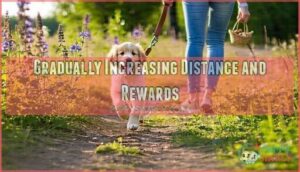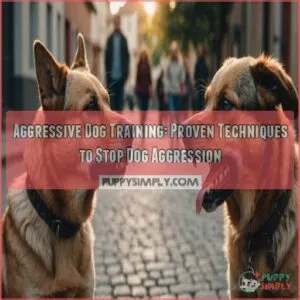This site is supported by our readers. We may earn a commission, at no cost to you, if you purchase through links.

Attach the leash and let them drag it around while rewarding calm behavior with treats. Practice basic commands like "sit" and "stay" before attempting walks.
When ready for outdoor training, use positive reinforcement – reward your puppy when they walk beside you instead of pulling. Keep initial walks short and fun, gradually increasing distance as they improve.
Consistency is key – daily practice sessions will yield the best results. The secret lies in understanding your puppy’s unique personality and adapting your training approach accordingly.
Table Of Contents
- Key Takeaways
- Leash Training Basics
- Train Puppy to Walk
- Leash Training Techniques
- Managing Leash Issues
- Benefits of Leash Training
- Frequently Asked Questions (FAQs)
- How do you train a dog to walk on a leash?
- How to start leash training for puppies?
- How to train a puppy to use a leash?
- How do you train a puppy to eat a leash?
- How do I get my puppy to walk away from home?
- Should I pull my puppy on a leash?
- When can you start taking your puppy for a walk?
- What age should you start leash training a puppy?
- What is the #1 trick to stop your dog from pulling on the leash?
- What is the fastest way to leash train a dog?
- Conclusion
Key Takeaways
- Start early with proper equipment – Begin leash training at 8-10 weeks old using a comfortable collar or harness, and let your puppy get used to wearing the gear indoors before attempting walks.
- Use positive reinforcement consistently – Reward calm behavior and walking beside you with treats rather than pulling or correcting your puppy, as this builds positive associations with the leash.
- Practice the "tree" technique for pulling – Stop moving completely when your puppy pulls and wait until they return to your side before continuing, teaching them that pulling doesn’t get them where they want to go.
- Keep training sessions short and gradual – Start with brief indoor sessions and slowly increase distance and duration as your puppy improves, maintaining daily practice for the best results.
Leash Training Basics
Teaching your puppy to walk on a leash starts with the right foundation and equipment. You’ll need proper supplies and knowledge of when to begin training for the best results.
Age Recommendations for Leash Training
Starting your puppy’s leash training journey early sets the foundation for a lifetime of enjoyable walks together.
The sweet spot for puppy leash training begins around 8-10 weeks old, when their brains are most receptive to learning.
Start early, stay patient—your puppy’s learning window is wide open at 8-10 weeks.
Here’s your puppy socialization timeline:
- 8-10 weeks: Start leash introduction indoors with collar/harness familiarization
- 10-12 weeks: Begin short indoor walks and basic leash manners
- 12-16 weeks: Shift to outdoor training after vaccinations are complete
- 16-20 weeks: Focus on loose-leash walking and advanced commands
- 4-6 months: Achieve full leash mastery with consistent training consistency
Critical periods matter—puppies introduced to leashes before 5 months show better long-term obedience and fewer behavioral issues.
Effective leash training methods are essential for a puppy’s development and safety.
Necessary Supplies for Leash Training
Once you’ve determined the right age to start, gathering the proper puppy supplies becomes your next priority.
Quality gear sets the foundation for successful leash training sessions and keeps your furry friend safe during outdoor adventures.
| Supply Category | Recommended Options |
|---|---|
| Leash Materials | Nylon (lightweight, durable) |
| Harness Types | Front-clip for pulling control |
| Collar Sizes | Flat, adjustable for growth |
Choose a 4-6 foot leash for ideal control during puppy leash training.
Avoid retractable leashes—they complicate training and reduce your steering ability.
Your puppy gear should prioritize comfort and safety over flashy designs.
Effective leash training techniques are essential for a well-behaved puppy.
Collar Vs Harness for Puppies
Once you’ve gathered your supplies, choosing between a collar and harness becomes your next decision.
Harnesses offer superior puppy safety by distributing pressure across the chest, protecting delicate necks from injury. They provide better leash comfort and control during puppy leash training sessions.
Harnesses protect your puppy’s neck while giving you better control during training sessions.
Consider these harness types and collar materials:
- Front-clip harnesses – Redirect pulling naturally, improving leash manners
- Step-in harnesses – Easy to put on squirmy puppies, adjustable for growth
- Flat collars – Lightweight option for calm puppies, holds ID tags
- Padded materials – Prevent chafing and rubbing during longer walks
Harnesses win for neck support and reducing pulling behaviors, while collars work for well-behaved pups who don’t strain against the leash. For ideal puppy safety, understanding dog harness benefits is essential for informed decisions.
Train Puppy to Walk
Once your puppy accepts their collar or harness, it’s time to introduce the leash and start actual walking training.
This step requires patience and consistency, but most puppies adapt quickly when you use positive reinforcement and keep sessions short and enjoyable.
Getting Puppy Used to Leash
Let the leash become your puppy’s new best friend through gradual leash introduction. Start by placing the leash near their food bowl during meals, creating positive associations.
Next, attach it briefly during playtime, letting them drag it around while supervised. This puppy leash training approach builds confidence naturally.
Focus on leash acclimation by rewarding calm behavior around puppy equipment. These leash training tips guarantee your pup develops proper leash manners from the start.
By using positive reinforcement techniques, you can effectively teach your puppy to walk nicely on a leash, which is a key part of proper leash manners.
Introducing Collar or Harness
Before your puppy can master leash training, they need to feel comfortable wearing their collar or harness.
Start by letting them sniff and explore the equipment – this builds positive associations from day one.
Choose between collar types and harness fitting based on your puppy’s size and breed.
For puppy comfort, introduce the gear gradually during playtime with treats and praise.
Equipment safety matters most, so guarantee proper fit to prevent chafing or injury during leash training tips sessions.
When selecting a collar, consider the importance of proper puppy collar sizing to guarantee a comfortable fit.
Initial Leash Attachment and Treat Rewards
After your puppy comfortably wears their harness, introduce the leash by letting them sniff it first.
Attach the leash and reward immediately with treats to create positive associations.
Allow your puppy to drag the leash around while supervised, building confidence through gradual leash familiarization.
- Start with sniffing – Let your puppy investigate the leash before attaching it to reduce anxiety
- Reward the clip – Give treats the moment you attach the leash to create positive reinforcement
- Supervised dragging – Allow your puppy to drag the leash while playing to build comfort naturally
- Perfect your treat timing – Reward calm behavior every few seconds during initial leash introduction sessions
Leash Training Techniques
Once your puppy is comfortable with the leash at home, you can start building their walking skills step by step.
These proven techniques will help you create a well-behaved walking companion who stays by your side without pulling or getting distracted.
They will enable you to have a well-behaved companion.
Gradually Increasing Distance and Rewards
Progress requires patience—your puppy’s leash training success depends on gradual progression and smart reward systems.
Start by rewarding every few steps, then randomly increase distance between treats. This distance management keeps your pup guessing and motivated.
Use positive reinforcement with high-value treats, gradually extending leash length as walking techniques improve.
Consistent distance training builds confidence and creates lasting puppy motivation for future adventures.
Transitioning to Outdoor Leash Training
Once you’ve mastered indoor leash training, outdoor environments present new challenges.
Start with quiet areas like empty parking lots before progressing to busier public spaces. Keep initial sessions short—10-15 minutes prevents overwhelm while building confidence.
Use high-value treats for distraction control when encountering other dogs, traffic, or urban walking obstacles. Stay calm and patient as your puppy adjusts to new sights and sounds.
Effective leash training requires understanding leash training techniques to address common challenges and facilitate a smooth shift to outdoor walks with leash training techniques.
Managing Leash Issues
Even well-trained puppies will test boundaries and develop challenging behaviors during leash training.
You’ll face common issues like pulling, lunging, and stubbornness, but with the right techniques, these problems become manageable stepping stones to success.
Redirection Techniques for Pulling and Lunging
When does pulling become a problem during walks? The moment your puppy starts tugging, become a "tree" and stop moving completely.
This pulling prevention technique forces them to refocus on you instead of whatever caught their attention. Use calm commands like "wait" while redirecting attention with high-value treats.
Turn 180 degrees and walk the opposite direction when persistent pulling occurs. These leash control methods teach proper leash manners training through consistent redirection rather than force.
Understanding the concept of loose leash walking is essential for effective puppy training and minimizing pulling issues.
Dealing With Common Leash Training Issues
When leash biting strikes, switch to a chain leash temporarily—it’s less rewarding to chew.
For freezing episodes, check your puppy’s comfort level and equipment fit. Most leash reactivity stems from overstimulation or fear.
Use calming techniques like stepping back from triggers and rewarding calm behavior. Puppy distractions are normal—redirect attention with treats rather than fighting the behavior.
These pulling solutions require patience, but consistent walking strategies will improve your pup’s leash training progress.
Gradual Improvement and Reduction of Treats
As your puppy shows consistent leash manners, you’ll begin tapering treat rewards strategically.
This gradual progress in positive reinforcement creates lasting walking techniques without constant food dependency.
- Reduce treat frequency gradually – Start by rewarding every third good behavior instead of every instance
- Maintain unpredictable reward systems – Keep your puppy guessing when treats will come during training sessions
- Replace treats with praise – Use enthusiastic verbal rewards and gentle petting as primary reinforcement methods
This puppy progress approach in leash training guarantees your dog develops genuine obedience rather than just food-motivated compliance.
Benefits of Leash Training
Leash training offers far more benefits than simply teaching your puppy to walk nicely—it’s an investment in their safety, your relationship, and their overall well-being.
From preventing dangerous situations to strengthening your bond, proper leash training sets the foundation for a lifetime of enjoyable walks together.
Safety and Security for Puppies
Safety becomes your priority when puppy protection meets real-world challenges.
Leash training provides essential injury prevention by keeping your pup away from traffic, aggressive dogs, and hazardous situations.
You’ll maintain public awareness of your dog’s location while ensuring emergency response capabilities.
Proper leash safety transforms chaotic walks into controlled adventures, giving you confidence to explore new environments together, which is a key part of puppy protection and overall leash training.
Strengthening The Owner-Dog Bond
Beyond protecting your puppy, leash training creates powerful moments that strengthen your relationship.
Walking together builds trust and emotional connection through shared experiences that transform routine walks into meaningful bonding exercises.
Here’s how leash training deepens your bond:
- Trust Building – Your puppy learns to follow your lead, creating mutual respect and confidence in your guidance during walks and playtime activities.
- Shared Experiences – Regular walks become quality time where you both explore the world together, strengthening your emotional connection through consistent positive interactions.
- Communication Development – Leash training teaches your puppy to read your cues and respond appropriately, improving overall communication and reinforcing good puppy leash manners that benefit every dog owner.
Preventing Unwanted Behaviors and Reducing Stress
Well-structured leash training creates a foundation of trust and predictability that dramatically reduces puppy anxiety and stress signals.
Through consistent positive reinforcement and behavior modification, you’ll prevent leash reactivity before it starts.
Calming techniques during training sessions help your puppy develop proper leash manners, reducing pulling and hyperactive behaviors by up to 40%.
This preventive approach saves you from costly behavioral issues later, promoting a more peaceful and predictable interaction, built on predictability and positive reinforcement.
Frequently Asked Questions (FAQs)
How do you train a dog to walk on a leash?
Like building Rome brick by brick, leash training requires patience and consistency.
Start indoors with a collar, let your dog drag the leash, then gradually hold it while rewarding calm walking behavior.
How to start leash training for puppies?
Start with introducing a collar or harness at home for a week.
Let your puppy drag the leash while playing, then gradually hold it during short sessions with treats and praise.
How to train a puppy to use a leash?
Like teaching a wild mustang to accept a bridle, leash training transforms your puppy’s natural freedom into controlled partnership.
Start indoors with a light collar, letting them drag the leash while playing before gradually taking hold and rewarding calm walking behavior.
How do you train a puppy to eat a leash?
You shouldn’t train a puppy to eat a leash.
Instead, redirect this behavior by offering appropriate chew toys, using bitter apple spray on the leash, and rewarding your puppy when they ignore it.
How do I get my puppy to walk away from home?
Gradual guidance gets your puppy comfortable walking away from home.
Start with short distances, using high-value treats and positive reinforcement.
Let them sniff and explore while maintaining loose leash control, building confidence gradually.
Should I pull my puppy on a leash?
Never pull your puppy on a leash.
Yanking creates fear and negative associations with walks.
Instead, become a "tree" when they pull—stand still until they return to your side, then reward them with treats and praise.
When can you start taking your puppy for a walk?
You can take your puppy for walks once they’ve completed their vaccination series, typically around 16 weeks old.
Before then, let them explore your yard or carry them to experience new environments safely, which is a complete concept for their development.
What age should you start leash training a puppy?
You can start leash training your puppy as early as 8 weeks old, right when they’re ready for their new home. This critical socialization window maximizes success.
What is the #1 trick to stop your dog from pulling on the leash?
You might think constant corrections are necessary, but become a "tree" instead—stop walking immediately when your dog pulls and wait until they return to your side before continuing.
What is the fastest way to leash train a dog?
Daily practice beats everything else.
Introduce the collar first, then add the leash indoors. Let them drag it around while playing.
Use treats to reward walking beside you without tension. Keep sessions short but consistent.
Conclusion
Practice makes perfect in the matter of how to leash train your puppy.
Remember that every successful walk started with a single step, and your patience will pay off.
With consistent daily training sessions, positive reinforcement, and the right equipment, you’ll transform leash struggles into enjoyable adventures.
Don’t get discouraged by setbacks—they’re part of the learning process, and soon enough, you’ll have a well-behaved walking companion who responds to your guidance and makes every outing a pleasure for both of you.
- https://www.kathysantodogtraining.com/
- https://www.ncbi.nlm.nih.gov/pmc/articles/PMC8465204/
- https://www.purina.co.uk/articles/dogs/puppy/behaviour/first-time-walking-a-puppy
- https://www.akc.org/expert-advice/training/teach-puppy-walk-leash/
- https://www.psychologytoday.com/us/blog/animal-emotions/202207/why-you-shouldnt-yank-dogs-leash













